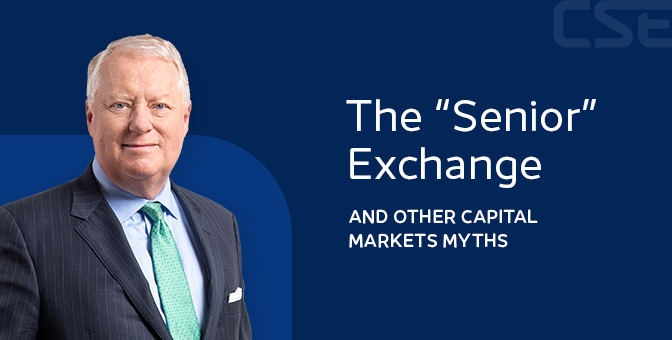These are tough times for many publicly traded companies. Valuations have declined alongside rising interest rates, and capital is incredibly difficult to come by across many sectors.
In a challenging market like this, some boards and management teams are trying almost anything to give their valuation, trading liquidity, and capital-raising opportunities a boost, however small. Not surprisingly, one of these moves is an old standby: switching stock exchanges.
We get it. Company leaders are right to ask for better value from their stock exchange — something we at the CSE, via our innovative thinking and superior customer service, are proud to say we bring to the table.
What is troubling, however, is when fiction overtakes fact. When market participants base their listing decisions on storytelling that is full of inaccuracies about how markets work in general, and about the CSE in particular, it not only sows confusion among investors and public companies alike, but it robs market participants of the true nature of the choices available to them. And it is obviously antithetical to fair and efficient market function.
Unfortunately, we have seen a few of these inaccuracies in the public sphere recently. So, I would like to take the time to correct a couple of myths about Canadian stock exchanges and lay out some clear truths about the CSE.
There is no such thing as a “senior” or “tier one” exchange
There are stock exchanges of various sizes in Canada. But the idea that certain exchanges are “senior” or “tier one” just isn’t so. The truth is that every stock exchange in Canada is regulated on the same basis.
All trading activity on each stock exchange is overseen by the Canadian Investment Regulatory Organization, which also administers the “timely disclosure” responsibilities of every public issuer. We are all in the same boat and must play by the same rules.
Referring to a stock exchange as “senior” is a misleading marketing tactic that confuses market participants about the structure and function of stock markets. It is a naked attempt to establish superiority over other exchanges that do not, in fact, exist.
The CSE is a stock exchange. Period. What differentiates exchanges are the issuers that they list. And contrary to what may be said about the CSE, we can list all issuers.
Anyone can invest in CSE securities
From the largest investment fund to the tiniest retail investor, everyone is eligible to invest in CSE issuers. To suggest otherwise is a myth.
Now here is where securities laws make investment more complex: Every Canadian issuer is classified as either “Venture” or “Non-Venture.” “Venture” issuers are typically smaller and less liquid, and certain institutional investors have mandates that prevent them from buying these securities. That is entirely understandable.
“Non-Venture” issuers are larger companies and face more demanding corporate governance requirements, including larger boards of directors and tighter reporting deadlines. The advantage of this designation is that they are eligible for inclusion in many more institutional funds.
The CSE offers issuers the opportunity to choose a “Venture” or a “Non-Venture” path. In fact, the CSE is uniquely positioned in the Canadian capital markets as the only exchange with regulatory approval to list both “Venture” and “Non-Venture” issuers.
CSE issuers are also eligible for membership in index funds offered by leading international providers. One notable exception is the S&P/TSX indices, which limit inclusion to companies trading on the TSX. But nothing prevents any index provider from including CSE securities if they meet the eligibility criteria for a particular index.
Market integrity rests on clarity
The Canadian stock exchange business is ultra-competitive at the best of times and even more so in the current market conditions. This competition provides opportunities for Canadian companies to access the capital that they need. But competition cannot and should not confuse or undermine fair and efficient markets. It is important that market participants have a complete understanding of what each exchange offers to ensure that issuers select the exchange that best meets their needs.
The CSE is proud to offer issuers a client-focused, low-fee, and innovative model that has driven our success over the nearly two decades of the Exchange’s existence. It has enabled us to grow from a startup with three listings in our first year to more than 800 listings today.
I will not call the CSE a “tier one” exchange because, again, there is no such thing. However, I firmly believe it is the leading Canadian exchange for entrepreneurs. By providing access to the Canadian public markets with exceptional service, support, and continuous improvement, we are leading the way in creating a vibrant and innovative marketplace.

